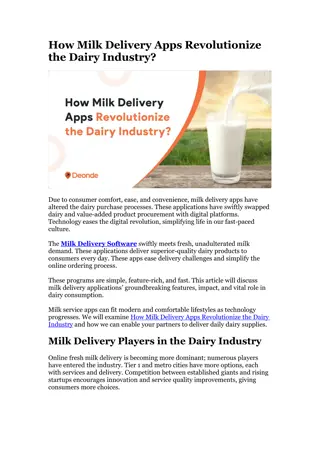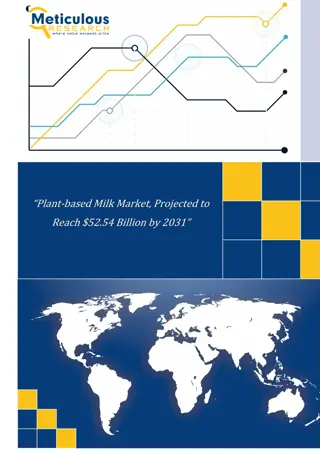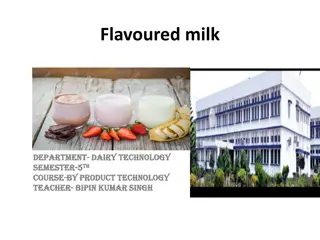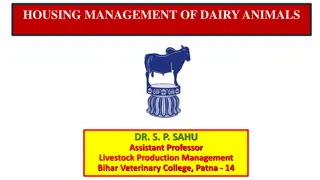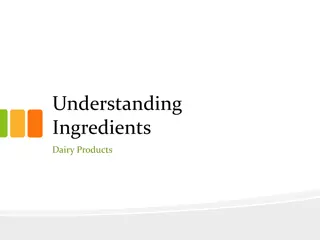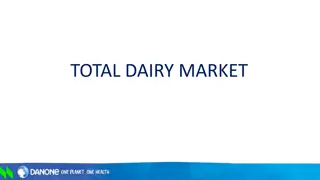Dairy Animals Management for Clean & Safe Milk Production
Dairy animals need careful management for clean and safe milk production. This involves quality control at the farm, processing, and homogenization stages to ensure compliance with standards of identity and purity set by regulatory authorities. Inspectors play a crucial role in monitoring various parameters to maintain herd health, milk quality, and sanitation practices. The process includes testing, inspections, and homogenization techniques to prevent cream separation and ensure consistent product quality.
Download Presentation

Please find below an Image/Link to download the presentation.
The content on the website is provided AS IS for your information and personal use only. It may not be sold, licensed, or shared on other websites without obtaining consent from the author.If you encounter any issues during the download, it is possible that the publisher has removed the file from their server.
You are allowed to download the files provided on this website for personal or commercial use, subject to the condition that they are used lawfully. All files are the property of their respective owners.
The content on the website is provided AS IS for your information and personal use only. It may not be sold, licensed, or shared on other websites without obtaining consent from the author.
E N D
Presentation Transcript
Management of Dairy Animals for Clean and Safe Milk Production Dr Manzoor Ahmad Mir Assistant Professor University of Kashmir, Srinagar drmanzoor@kashmiruniversity.ac.in 9797110211 Free Powerpoint Templates Free Powerpoint Templates Page 1
Fluid Milk Collodial dispersion of the protein caesin and the whey proteins. It is an emulsion with fat globules suspeneded in the water phase Composed mainly of water 87-89% Milk solids make up the other 12-13% Solids include the carbs, lactose, fat, protein and minerals Solids-not-fat Excludes the fat and includes the caesin, whey, lactose, proteins, minerals
Quality Control Quality Control On the farm Inspectors monitor herd health, farm water supply, sanitation, milk temperature, holding times, bacteria counts Violations of health standards result in heavy penalties up to and including suspension from business Inspections occur both at the farm and processing plants on a regular on-going basis Inspectors have full authority to suspend plant operations in order to conduct detailed examinations of all equipment, facilities and products The dairy industry works hard to ensure that they comply with or exceed all regulations Finished dairy products Tested regularly by state inspectors to ensure compliance with Standards of Identity Refers to criteria such as moisture, butterfat, protein content Purity Refers to pathogens and residues criteria The Food and Drug Administration (FDA) sets the standards of identity for beverage milk products
Processing and Homogenization Processing and Homogenization When milk arrives at the plant it is checked to make sure that it meets the standards for temperature, total acidity, flavor, odor, tanker cleanliness and absence of antibiotics Butterfat and solids-not-fat content is analyzed These amounts will vary with the feed, breed of cow and time of year These are also used along with the volume to determine what the producer will be paid Once the milk passes these receiving test it is pumped into large refrigerated silos Homogenization Prevents the cream from rising to the top A homogenizer forces milk under high pressure through a valve that breaks up butterfat globules to such a small size that they will not coalesce (stick together) Does not affect the nutrition or quality
Pasteurizing Pasteurizing Heating the raw milk to kill all pathogenic microoranisms that may be present Not sterilization After pasteurization some harmless bacteria may still be present these are the bacteria that cause milk to go sour Refrigeration is the best way to slow the growth of these organisims Low Temperture Longer Time (LTLT) Heats milk to at least 145 degrees F for at least 30 minutes Can cause a cooked flavor Not used by some milk plants for fluid milk products High Temperture/Short Time (HTST) Heats milk to at least 161 degrees F for at least 15 seconds Milk is immediately cooled to below 40 degrees F and packaged in plastic jugs or plastic coated cartons Ultrapasteurization Heating milk to 280 degrees F or higher for 2 seconds followed by rapid cooling to 45 degrees or less Ultrahigh Temperture Processing Sterilizes the milk Heats it to 280-302 degrees for 2 to 6 seconds Milk is aseptically packaged and does not require refrigeration until it is opened
Packaging Once milk is separated, standardized, homogenized and pasteurized it is held below 40 degrees F Then it is packaged into gallon, gallon, quart, pint and half pint containers Packaging machines are maintained under strict standards All equipment is washed daily Automatic clean-in-place systems guarantee consistent sanitation with minimum manual handling to reduce the risk of contamination Once packaged the products are conveyored to cold storage where they are stored for a short time before being shipped to supermarkets where they are kept in cold storage or refrigerated display cases
Free Powerpoint Templates Page 7
Growing global demand for milk and milk products (approximately 3% annually). Indian dairy industry the largest milk producer country in the world with 112.5 million tonnes in 2009-10. (BAHS, 2010) Consumers are increasingly concerned about the safety of their food. Potential threats to human health related to milk and milk products: include contamination of milk before or during milking or post milking handling consumption of raw milk, errors in pasteurization, emergence of antimicrobial resistance in zoonotic pathogens, chemical adulteration of milk, transmission of zoonotic pathogens to humans through animal contact, and foodborne disease related to cull dairy cows. Free Powerpoint Templates Page 8
Constraints----- Production of clean and safe milk in India is really a challenge! Indian dairying is characterized by very small - most producers own 1 to 3 milch animals and largely a rural-based activity. In India milk is produced by masses contrary to the mass milk production of some developed countries. India has a unique pattern of production, processing, consumption and marketing of milk, which is not comparable to any developed nation. Pricing policy of milk Free Powerpoint Templates Page 9
Unorganised sector Milk production Organised sector Free Powerpoint Templates Page 10
Clean and safe milk? milk drawn from the udder of healthy animals, which is collected in clean, dry milking pail and free from extraneous material like, dirt, dust flies, hay , manure etc. clean milk has a normal milk flavor with low bacterial count and is safe for human consumption. Raw milk quality encompasses criteria relating to composition (butterfat, protein, lactose, milk solids etc) and hygiene (total bacterial count, somatic cell count). Of these, somatic cell count (SCC): An udder quarter is considered healthy if it has an SCC < 100,000 cells/ml and is free of mastitis pathogens. (Hamann 2005) The European Union milk quality standard (SCC not exceeding 400,000 cells/ml) is generally accepted as the international export standard. Free Powerpoint Templates Page 11
The importance of clean and safe milk The milk quality is important as it impacts on farm profitability, milk processing, human health, keeping quality etc. Onfarm profitability Milk processing Increased somatic cell counts are associated with reduced milk yield. Milk quality has a substantial, adverse impact on milk processing. Mastitis is associated with an influx of somatic cells and increased activity of heat-stable proteases and lipases, leading to a breakdown of casein and milk fat. (Barbano et al. 2006) Free Powerpoint Templates Page 12
Human health Herds with mastitis problems are also at increasing risk of antibiotic residue violation, as a result of increased antibiotic usage. (van Schaik et al. 2002) Mastitis also affects the quality of pasteurized liquid milk and reduces its shelf life. (Ma et al. 2000) Quality milk renders protection against diseases like typhoid, dysentery, etc. which are transmitted to the milk thorough human contact. Heat-stable enterotoxins produced by Staphylococcus aureus in milk from infected cows have been implicated in cases of food poisoning. Free Powerpoint Templates (National Mastitis Council 2005) Page 13
Factors affecting clean and safe milk production Milk secreted from the healthy udder is almost sterile. Milk needs to be protected from all possible sources of microbial contamination as it may act good media for pathogenic organism. Milk gets easily contaminated and that s why considered as perishable commodity. The factors responsible for clean and safe milk can be classified into two categories: 1) internal factors 2) external factors. Free Powerpoint Templates Page 14
Managemental strategies for clean and safe milk production Good Milking management Milking is an art requiring experience and skill. Milking should be conducted gently, quietly, quickly, cleanly and completely Cleanliness of animals The hind quarters and thighs of cows should be brushed, and washed if lot of filth-is accumulating on them. Free Powerpoint Templates Page 15
Correct milking method Stripping and full-hand milking are the two commonly used methods of milking. Many milkers tend to bend their thumb in, against the teat while milking, known as knuckling. Stripping causes more irritation to teats due to repeated sliding of fingers on teats; and so discomfort to cows. Free Powerpoint Templates Page 16
The first few strips of milk from each teat should be let on to a strip cup to see clotes in milk for possible incidence of mastitis. Premilking teat stimulation of 10 to 20 s is generally considered adequate to achieve efficient milk letdown and removal (Reneau and Chastain, 1995) Milking time and timely milking Complete milking has to be done, lest the residual milk may act an inducer for mastitis causing organisms and the overall yield may also be less. Milkers as well as the milking pails should be clean. The milkers should wear clean dress. Nails should be well trimmed and their hands clean and disinfected between each milking by washing in antiseptic solution. Free Powerpoint Templates Page 17
Predipping The procedure for predipping involves washing of teats with water and a sanitizer. The teats are then dried with an individual paper towel and dipped or sprayed with the sanitizer. A 30-second contact with sanitizer is needed to kill organisms. Then the sanitizer is wiped off of the teat with a paper towel. (Reneau and Chastain, 1995) Postdipping Applying teat dip to every quarter of every cow after every milking. Used to remove milk residue left on the teat and kill organisms on the teat at the time of dipping. They also leave a residual film of sanitizer between milkings. Free Powerpoint Templates Page 18
Keeping cows standing after milking seemed to be associated with lower SCC (livaart et al. 2007) Dairy producers attitudes Clipping of udder hairs Regular CMT Free Powerpoint Templates Page 19
Feeding management for clean and safe milk Good nutrition of dairy cow reflects in the term of quantity and quality of milk Dusty or very fine concentrate during milking of animals should be avoided for clean milk production. Feeding of milch animals should be done an hour before milking. Silage and wet crop residues should not be fed at milking place as it may impart foul odour to the milk. Animal feed and fodder should also be free from anti- nutritional factors and toxins. Free Powerpoint Templates Page 20
The presence of unsuitable substances such as industrial and environmental contaminants, pesticides, pathogenic agents, and toxins in feed should be critically assessed for safety aspects before using Feed and fodder used for milch animals should be free from fungicides, herbicides, insecticides, pesticides, fumigants, heavy metals etc. Feeding a specific type of feed, mineral, or supplement is absolutely determined by the presence or absence of other components of a diet. Vitamin E & Selenium (Bouwstra et al., 2010) Free Powerpoint Templates Page 21
Housing management for clean and safe milk Housing of dairy animals should be designed to provide good drainage, well ventilation and sufficient lights. This requires attention to stall design, bedding, and cleanliness and hygiene of stalls. The dirty floor of milch animal may acts as good source of ascending type of infection in udder. Free stall housing system with sand-bedding (not a minor correction). Bacteria of environmental origin are most likely to pass directly through the duct when it is not completely closed. (Lacy-Hulbert and Hillerton, 1995) Free Powerpoint Templates Page 22
Overcrowding results in excessive deposition of manure in housing areas that are designed for fewer animals. Manure handling, type of bedding and maintenance of cow beds all have major influences on hygiene. Loose consistency of manure Infection is more common when animal arrives and lies down on the paddock just after the milking. Immediately after the milking the opening of teat canal is loose and more prone for infection. (Lacy-Hulbert and Hillerton, 1995) Free Powerpoint Templates Page 23
Therefore, the stalls of animal should be clean and dry with adequate bedding to minimize infection. The gutter and passage way should be regularly cleaned and scrapped to remove manure from the animal shed. In very wet areas sprinkling slaked lime over the surface helps to dry it out quickly. The floor of the milk shed should be swept with the clean water and disinfected with one percent bleaching powder solution. Sufficient supply of safe and potable water for drinking, washing udders and flanks of the animals, utensils etc. should be ensured. Control of flies and other insects is important as they act as potential source for disease transmission. Free Powerpoint Templates Page 24
Heath management for clean and safe milk Vaccination of animals against FMD, HS, brucellosis etc. should be done regularly. Routine examination of animals should be against diseases like; TB and brucellosis. The animals suffering from contagious disease must be kept separate from healthy herd. Appropriate dry cow therapy should be promoted at dairy farm. Free Powerpoint Templates Page 25
Dual objectives of dry-cow antibiotic treatment 1. prevention of new IMI during the dry period 2. cure of existing of IMI (Dingwell et al. 2003) The inappropriate or prophylactic use of antimicrobial agents must be minimized The diagnosis of salmonellosis or listeriosis on a dairy farm should be regarded as an indication that other potentially infected animals may be present in the herd. Coliform counts on bulk tank milk should be routinely performed as an indicator of fecal contamination. Well-defined culling strategies based on udder conformation, teat lesions. (Rodrigues et al., 2005) Free Powerpoint Templates Page 26
Conclusion Programme should built around the establishment of goals for udder health and periodic review of mastitis control programme. A broad range of resources should be developed to support these steps, including farmer short courses, farm guidelines, mastitis action plans, mastitis focus reports and milk quality awards. Effective translation of knowledge to practice, rather than incomplete knowledge per se. Free Powerpoint Templates Page 27




